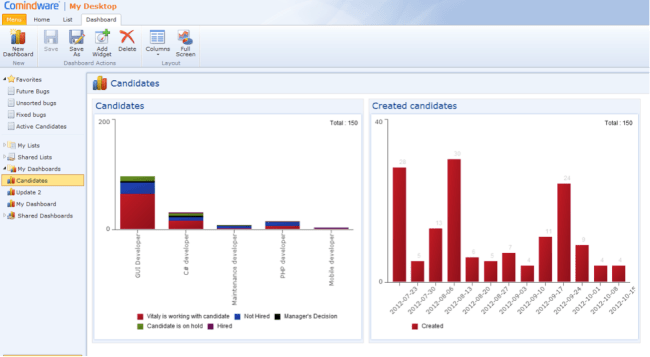Easier Hiring Process Management with Comindware Tracker
Friday, January 31, 2014 / Updated: January 31, 2014
Let’s create a scenario.
You’re the CEO of a mid-sized company that’s continually expanding, therefore, with considerable staffing requirements. For every position that opens, around 20 candidates become interested. From the pool of 20, some submit every required paper work while others need to be reminded several times to remember. From those who are offered a job contract, some turn down the offer without batting an eyelash while others need time to think things through.

Some positions, due to the unavailability of a suitable candidate, remain open for more than six months. Within those six-plus months, the company continually receives applications, emails with document attachments, or phone calls from candidates following up on the status of their applications.
If you’re responsible for final candidate screening, considering the job positions still waiting to be filled, more and more file folders may be dumped onto your desk every passing week. Even if you’re not directly involved in the hiring processes, since you’re the CEO, naturally, you would want to know what your hiring team has been doing and whether your staffing targets will be achieved on time or not.
Table of Contents
Turning a bad situation around
It’s a scenario you and your hiring personnel contend with for every vacancy, and despite your best efforts to create a working system combining spreadsheets, email threads and third-party documentation software, the workload is still too much for you all to handle.
What results is an HR hiring process so tedious that staffing gaps aren’t addressed in a timely manner, or if they are because of timing considerations, the new hires aren’t necessarily a good fit. You know how the story ends if the people you hire don’t gel well with your company’s culture or aren’t equipped with the necessary skills to get the job done.
What’s the best way to turn the situation around?
Create a hiring process management system that’s simple and easy to implement.
Your hiring process management and Comindware Tracker
Hiring process management doesn’t have to be complicated. In the image below, you see a Comindware Tracker process workflow that reflects the actual activities your hiring team is undertaking with a candidate. From start to finish, the steps are crystal clear, and the workflow gives you a real-time snapshot into the status of a candidate’s application – whether that’s awaiting manager decision, still in an interview or has passed all screening procedures and now reviewing the contract proposed.

Aside from visibility that allows you and the Human Resources hiring process team to make accurate forecasts and projections, another significant advantage of Comindware Tracker is that tasks are automatically assigned to team members, kicking off with an email notification sent out to the next person in the process chain.
Depending on how the HR hiring process goes in your company, you can add to or delete tasks from the above hiring processes workflow template with drag-and-drop ease.
Documents, lists and reports – all in a single system
When the best possible candidates have been determined for final consideration, especially if the position is a significant one for the company, what sometimes happens is that a meeting is called, documents submitted by the candidates, including those made by the hiring processes panel, are reviewed, and a brainstorming session ensues.
While this is certainly a valid way of getting the final phase of the HR hiring process rolling, consider the following:
- A meeting has to be scheduled.
- Documents have to be printed out.
- The brainstorming cannot take place if the meeting isn’t called and the essential documents are reviewed.
Circumstances won’t always be perfect for the parties involved, and a meeting may not be feasible. With Comindware Tracker, documents are stored under appropriate work items, which authorized members can access for review anywhere and anytime – no need for meetings and printouts. Plus, remarks, observations and annotations are stored in threaded comments that are available to everyone in the team, as opposed to discussions in numerous email threads and messaging platforms that can eventually be difficult to locate and track.
You can also build special lists that can be sorted and filtered using specific criteria, like job positions that are still open, application submissions filed on a certain date, list of candidates who still need to be interviewed, and so on.
For your reports, you can create graphs and charts, like in the example below, with just a few mouse clicks.

Conclusion
I’m sure you’ve heard the cliché about the workforce being the backbone of an organization. Clichés are clichéd for a reason. No matter how trite they sound overtime, they remain true. No company can properly function without the people comprising it, which is why the Human Resources hiring process is such an important aspect for any business.
Because it is that important, giving it what it deserves by simplifying and optimizing the routine part of the process is a good move. This leaves you and your hiring team more time to concentrate on the more value-adding aspects of HR, such as creating partners and brand advocates out of your own employees.



Posted on: in Project World, Solutions